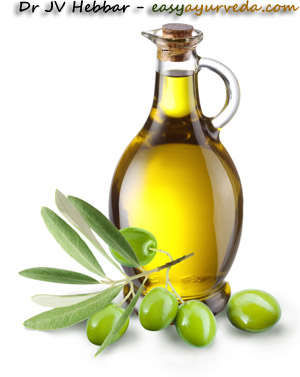How To Know If An Ayurvedic Oil Can Be Taken Orally Or Not?
For the purpose of this article, by the word “traditional Ayurvedic oil”, I mean, a traditional Ayurvedic oil, the reference formula of which, is there in traditional Ayurvedic textbooks. Usually these oils will end with – Thailam, Tail, Thaila, Taila,. etc (there are some exceptions, like Mahanarayana oil is a traditional Ayurvedic oil,whose original name is Mahanarayana taila). The label of such an oil would have “Ayurvedic medicine” mentioned on it.

The other type of oil, that I am not including into Traditional oil category, is, those oils, whose formula is prepared by the company itself, and is not mentioned in Ayurvedic text books – such as Sandhi Sudha oil, Indulekha Bhringa Hair oil, etc
All the traditional Ayurvedic oils are not indicated for oral administration. Such as, any traditional hair oil, – like Mahabhringaraja taila – it is meant to apply on hair.
But some Ayurvedic oils can be taken orally as well as applied externally for massage etc
For example,
Narayana taila – It is used orally in cases of low sperm count, it is used as nasal drops in case of sense organ disorders, vision problems, locked jaw, etc. it is also applied locally to relieve muscle pain, joint pain etc.
Mahamasha taila – It is used orally, it is used for enema treatment (Anuvasana basti – oil enema), for treating muscular dystrophy, migraine etc. It is also applied externally to treat rheumatoid arthritis, to improve muscle strength etc.
Dhanwantaram tailam – used both externally and orally for rheumatoid arthritis, paralysis, spondylosis etc.
Brihat Saindhavadi taila – It is used orally, as enema and for massage, Dhara etc, in the treatment of low back ache, sciatica, rheumatoid arthritis, abdominal colic, etc.
Other such examples are – Maharajap Prasarini taila, Bala taila, Bala Dhatryadi taila, Sahacharadi taila, Karpasasthyadi taila etc.
But some traditional Ayurvedic oils are strictly forbidden for oral use –
It may not be suitable because of poisonous herb used in it, but they are safe for external application – for massage etc.
Example:
Vishagarbha taila – used externally for neck rigidity, joint stiffness etc, this oil contains Dattura, so, orally not suitable.
Malatyadi Taila – used in treating alopecia, but cannot be consumed orally due to presence of Karaveera – Nerium indicum.
BUT
The game is not this simple.
Because, there are these pharmaceutical companies, which may be adding preservatives, anti oxidants, perfumes, artificial colors etc to the oil making, even the safest oil is not safe for oral consumption.
So, even if your Ayurvedic doctor has prescribed an Ayurvedic oil for oral consumption, double check.
If the oil contains abnormally beautiful odor, abnormally elegant color, take the product to doctor and ask.
If it is scented, if you think it contains added perfume, do not use orally.
If the oil label does not mention oral use, double check with doctor.
If the doctor is not available, you can call the manufacturer customer care number, printed on the label. Before speaking, convey it to them that you are recording the call.
In countries like USA, there is strict regulation that the label should clearly disclose all the ingredients that the product contains. Hence, looking into the label, you can know for sure about preservatives, perfumes etc. So, that is a big advantage.
Having said all these, there are some Ayurvedic oils, that are definitely meant for oral use.
Definitive oils for oral use:
ksheerabala 101 and dhanwantaram 101
101 indicates that the oil is processed multiple times to suit for oral consumption. This process is called as Avartana, it is for the purpose of fortification.
So, if you have ksheerabala 101 oil, for example, it is definitely suitable for oral consumption, assuming that it has not crossed expiration date of 3 years from the date of manufacture.
Based on this theory, there are many proprietary (company formulated) herbal oils, which are also suitable for oral consumption – such as Cervilon oil – used for cervical spondylosis, lumbaton soft gel capsule – an herbal oil, in capsule for ease of administration etc.
Summary:
A Traditional Ayurvedic oil can be used orally,
– if the label indicates that it can be taken orally.
– if the label contains oral dose of medicine – like – 2 – 5 drops once or twice day. Or oral dose – as per physician’s advice.
– if it is 101 oil.
– if manufacturer double-assures that it can be used safely through oral route.









4 comments
Francis Thuruthimattom
Very good article. What about rukunoil, is it for external or oral use?
Dr J V Hebbar MD(Ayu)Author
Please refer the label or contact manufacturer.
Dr J V Hebbar MD(Ayu)Author
You can take Til oil orally – half a teaspoon in the morning, before breakfast. It is best to drink lukewarm water, after having it.
Srividhya
Hello Dr. J V, shall I know any medicine to gain healthy weight and become little chubby. Coz i am skinny girl